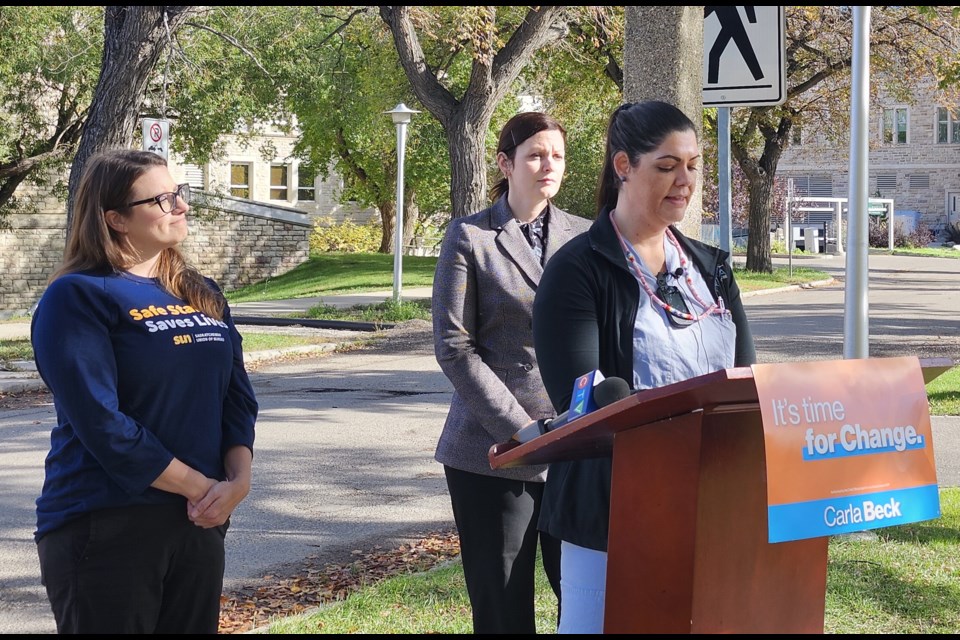SASKATOON — Sara Peters said healthcare workers had to become resourceful during what she described as years of neglect by the Saskatchewan Party leadership since they assumed power in 2007.
She said the Saskatchewan Party-led government—11 years under Brad Wall and six with Scott Moe as premier—failed to address the problems they had been highlighting more than a decade ago.
Peters joined St. Paul’s Hospital emergency room nurse Stephanie Fehr and Saskatoon Fairview candidate Vicki Mowat in a press conference at the corner of Clinic Place and Memorial Crescent outside the Royal University Hospital to say the Saskatchewan Party’s failure to take action and, at times, deliberately ignoring the city's ER crisis, has now brought things to a breaking point.
“That's the beauty of emergency nurses; we are resilient and resourceful. We can figure out any problem and troubleshoot to the best needs of our patients and what's presented in front of us. We're great at reacting, which is a double-edged sword because we've padded the healthcare system for so long that we can't do anymore. We have run out of our ability to manage the volume, and the acuity and patient safety are grave concerns for us,” said Peters, a 19-year veteran working as an ER nurse.
“So, if we can't get some help from a government and leadership, then I don't know how we will move forward from the current state. I have 19 years under my belt, so I've developed ways to cope and segregate, attributed to my longevity in [the ER]. I am seeing our turnover to be a lot higher than it ever was. They say the life of an emergency nurse is two years because the stress and anxiety that's attributed to our work environment leads people to choose other streams of employment.”
She added that she had colleagues who chose to leave nursing after only two years of working at the ER or in a city hospital.
“Sometimes we're stuck in a cycle of orientation, and our nurses coming into the emergency line aren't even finishing orientation before they're like: ‘Sorry guys, this isn't for me. I need to find something more suitable to a work-life balance,’” said Peters.
Fehr, a Saskatchewan Union of Nurses member, backed up Peters’ statement. She, too, was forced to leave her job as an ER nurse at St. Paul’s Hospital due to burnout and fatigue after the lack of support, she said.
“Support and knowledge transfer are the largest parts of growing a successful and competent emergency nurse. And by those in power not caring about this crisis, we have hemorrhaged our senior staff due to the psychological trauma they have been put through. This leaves our junior staff feeling unsupported and have also started quitting. Some only after six months. It's unbelievable,” said Fehr.
“I myself was pushed to leave in 2021 because of the moral injury the weight of the system placed on me. I only came back because I believe in the work of emergency departments and I believe in the strength and resilience of the staff that work there. But, I do not believe the current government cares about healthcare. They don't even have healthcare listed as one of their priorities in their campaign plan.”
Fehr added that the problem of overcapacity in hospitals began before the COVID-19 pandemic. “We also had the worsening over-capacity situation happening already at that point. I would say it's probably at least been going on for over five years. RUH has consistently struggled with capacity issues. At St. Paul's, we've only started using hallway beds and these extra spaces, I would say, in the last five years. It is a newer problem for us, but still for years.”
Fehr said they need extra help like they had during COVID.
“During the pandemic, we had some processes in place, some extra funding for nurses, which provided relief. But that was temporary funding, right? All that's gone, all that extra help is gone, and then there's been nothing put in its replacement even when we see our volumes and acuity steadily increasing.”
Peters added, “At RUH, it's been longer [over-capacity] than that. It's been closer to 10 or 12 years that we've seen the capacity steadily increasing. We've used hallway beds inconsistently since 2007, and they have only deteriorated since then. The acuity we're seeing in the hospitals and the volume of patients has increased, and we haven't had any strategies or processes to mitigate those increases. In my experience, hallway beds have been consistent since 2007.”
Mowat said the challenge of overcapacity should be considered, especially when shuffling nurses and other healthcare staff. Patient care suffers when resources are not provided to deliver the needed care, she said.
“That can be anything from the physical bodies, the people who are providing care, to stretchers, to running out of oxygen, to having patients treated in hallways where there's a temporary call bell or no call bell available, no privacy so people can't have the human decency of having some private space for some very personal conversations. There are all these different ways that patient care suffers when we have these extreme overcapacity issues in emergency rooms,” said Mowat.




